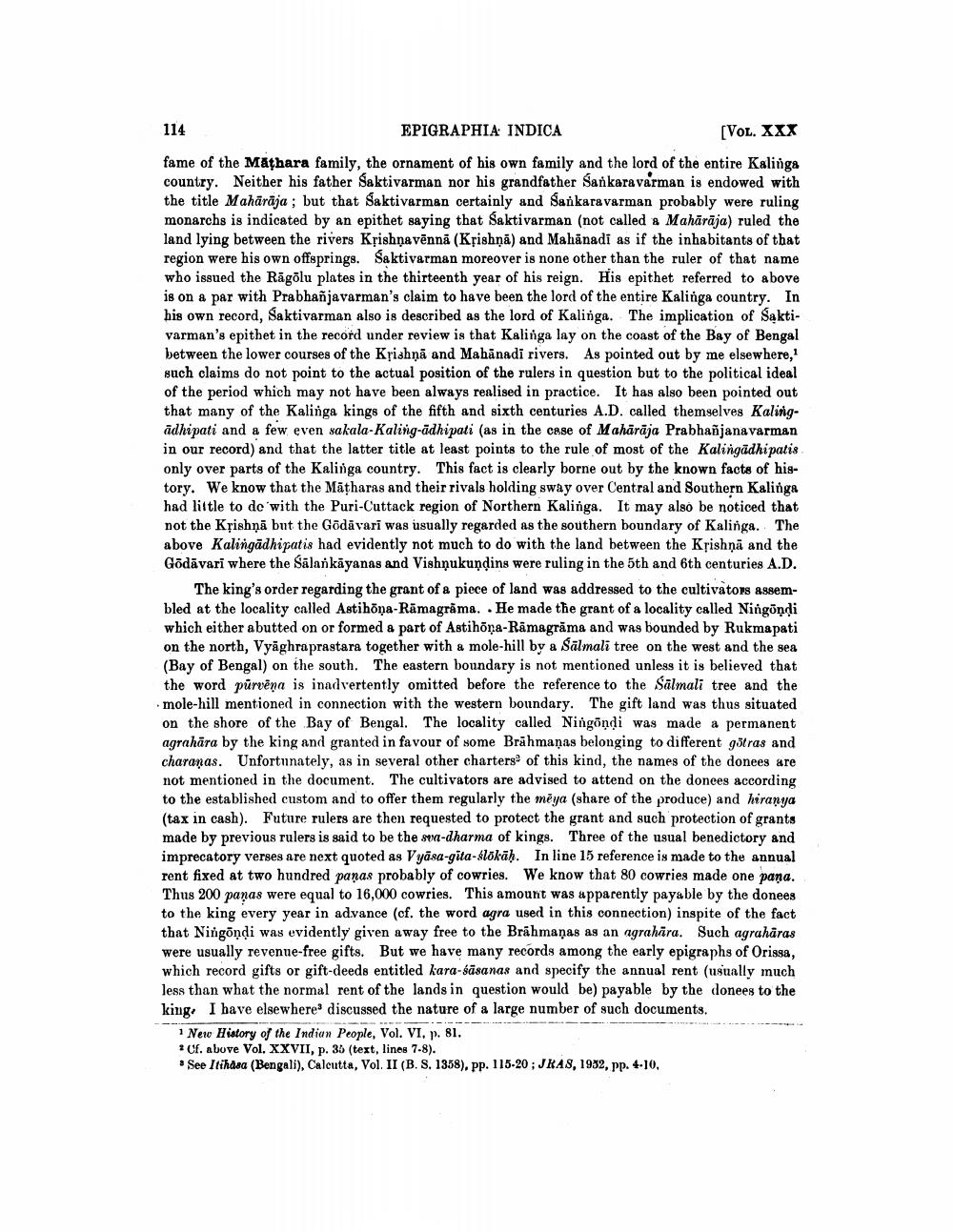________________
114
EPIGRAPHIA INDICA
[VOL. XXX fame of the Mathara family, the ornament of his own family and the lord of the entire Kalinga country. Neither his father Saktivarman nor his grandfather Sankara varman is endowed with the title Mahārāja ; but that Saktivarman certainly and Sankaravarman probably were ruling monarchs is indicated by an epithet saying that Saktivarman (not called & Mahārāja) ruled the land lying between the rivers Krishnavēnnā (Kfishņā) and Mahanadi as if the inhabitants of that region were his own offsprings. Saktivarman moreover is none other than the ruler of that name who issued the Rāgõlu plates in the thirteenth year of his reign. His epithet referred to above is on a par with Prabhañjavarman's claim to have been the lord of the entire Kalinga country. In his own record, Saktivarman also is described as the lord of Kalinga. The implication of Saktivarman's epithet in the record under review is that Kalinga lay on the coast of the Bay of Bengal between the lower courses of the Krishņā and Mahānadi rivers. As pointed out by me elsewhere, such claims do not point to the actual position of the rulers in question but to the political ideal of the period which may not have been always realised in practice. It has also been pointed out that many of the Kalinga kings of the fifth and sixth centuries A.D. called themselves Kalingādhipati and a few even sakala-Kaling-ādhipati (as in the case of Mahārāja Prabhañjanavarman in our record) and that the latter title at least points to the rule of most of the Kalingādhipatis only over parts of the Kalinga country. This fact is clearly borne out by the known facts of history. We know that the Mātharas and their rivals holding sway over Central and Southern Kalinga had little to do with the Puri-Cuttack region of Northern Kalinga. It may also be noticed that not the Krishņā but the Gödāvari was usually regarded as the southern boundary of Kalinga. The above Kalingādhipatis had evidently not much to do with the land between the Krishnā and the Gödāvari where the Salankayanas and Vishnukundins were ruling in the 5th and 6th centuries A.D.
The king's order regarding the grant of a piece of land was addressed to the cultivators assembled at the locality called Astihõņa-Rāmagrāma. . He made the grant of a locality called Ningõndi which either abutted on or formed a part of Astihõņa-Rāmagrama and was bounded by Rukmapati on the north, Vyāghraprastara together with a mole-hill by a Salmali tree on the west and the sea (Bay of Bengal) on the south. The eastern boundary is not mentioned unless it is believed that the word pūrvēna is inadvertently omitted before the reference to the Sālmali tree and the mole-hill mentioned in connection with the western boundary. The gift land was thus situated on the shore of the Bay of Bengal. The locality called Ningõndi was made a permanent agrahāra by the king and granted in favour of some Brāhmaṇas belonging to different g5tras and charaņas. Unfortunately, as in several other charters of this kind, the names of the donees are not mentioned in the document. The cultivators are advised to attend on the donces according to the established custom and to offer them regularly the měya (share of the produce) and hiranya (tax in cash). Future rulers are then requested to protect the grant and such protection of grants made by previous rulers is said to be the sa-dharma of kings. Three of the usual benedictory and imprecatory verses are next quoted as Vyāsa-gita-slökāḥ. In line 15 reference is made to the annual rent fixed at two hundred paņas probably of cowries. We know that 80 cowries made one pana. Thus 200 paņas were equal to 16,000 cowries. This amount was apparently payable by the donees to the king every year in advance (cf. the word agra used in this connection) inspite of the fact that Ningöndi was evidently given away free to the Brāhmaṇas as an agrahāra. Such agrahāras were usually revenue-free gifts. But we have many records among the early epigraphs of Orissa, which record gifts or gift-deeds entitled kara-śāsanas and specify the annual rent (usually much less than what the normal rent of the lands in question would be) payable by the donees to the king, I have elsewhere discussed the nature of a large number of such documents.
1 New History of the Indian People, Vol. VI. p. 81. * Cf. above Vol. XXVII, p. 35 (text, lines 7-8). • See Itihasa (Bengali), Calcutta, Vol. II (B. S. 1358), pp. 115.20 : JKAS, 1982, pp. 4-10,




